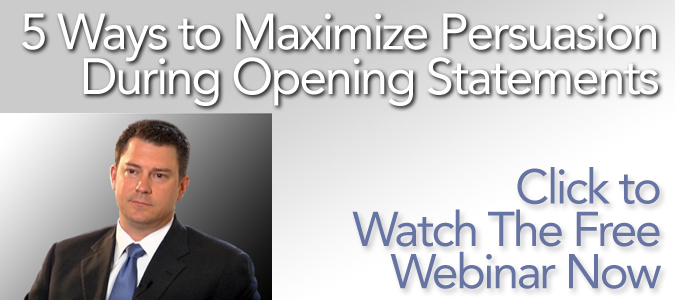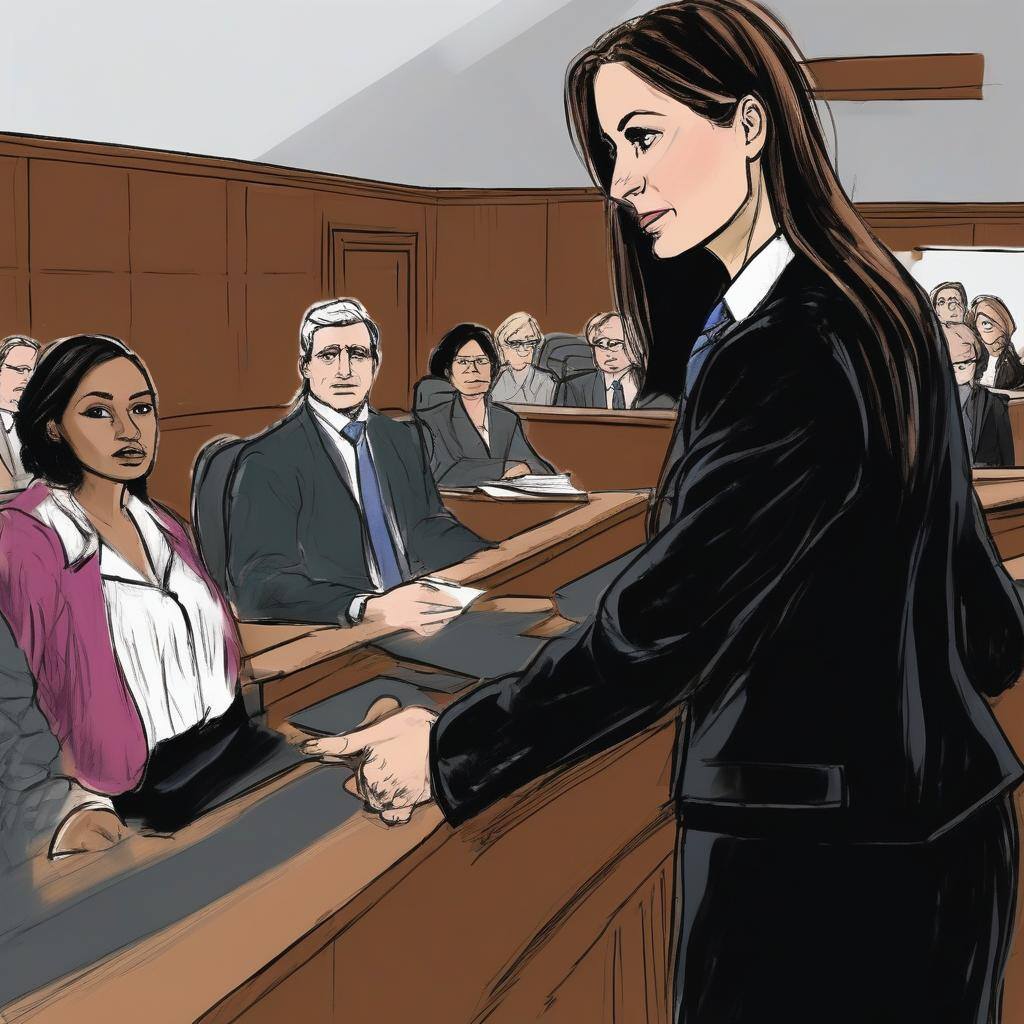80% of jury trials are won or lost in the opening statement. 80%!!!!!!
If you lose to your opponent in opening statements, your chances of winning the case become very slim.
Over the past 25 years, I have participated in the drafting of hundreds of opening statements. Sometimes, it's 20% me (and others) and 80% first chair trial counsel; sometimes, it's the other way around. No matter what, it is always a collaborative process. And it's one of the things I enjoy most about my job.
Reflecting on these 25 years, I offer twenty-one tips for writing and presenting a winning opening:
- Simplify, simplify, simplify. The opening statement can’t be too simple. Many people say ninth grade is your audience, but I would suggest sixth grade. Since those of us in the legal industry tend to hang around smart people all the time, writing or speaking at that level is hard. The only way to do it, unless you happen to have a very patient sixth grader on hand, is through practice in front of a trial consultant. See Litigator & Litigation Consultant Value Added: A "Simple" Final Product
- Tell a story. We have many storytelling resources, specifically Storytelling for Litigators and The Opening Statement Tool Kit. My colleagues and I have spent years putting these FREE guidebooks together, and there's nothing else like them. See also 5 Ways to Maximize Persuasion During Opening Statements - Part 2
- I am often asked how long my opening statement should be. I think your opening statement should be less than 45 minutes. Nothing is magical about that number, but I feel it's about as long as people want to pay attention to something. It's no accident that many shows and college classes are offered in 50-minute segments. When was the last time you didn't fidget with your phone during a full-length movie? Sidebar: I feel like there should be a list of movies that are easy to watch while playing on your phone.
- Practice until it’s perfect. I recommend a 30-to-one practice ratio (so if you have a 50-minute opening, your practice goal should be 25 hours, but many can do it faster. See The Magic of a 30:1 Presentation Preparation Ratio. Practice alone often, and practice with your sixth grader or a suitable stand-in. I would love to help you. You can find me by clicking here.
- Practice at least one time when your colleagues can object. Objections during opening are pretty rare. Most consider it gauche, but some consider it a sport. It does happen, and you should be ready for it. It can throw off your whole game. What is the solution? Practice.
- Practice your opening in front of groups of people. Zoom makes this easy. Also, practice it frequently with one supportive person you trust. Your trial consultant is a very good resource.
- Find your "if the glove doesn’t fit, you must acquit" moment. Many people consider this a turn-off, at least in this example, but you can't argue against its effectiveness. Search for it. It will take weeks or months to find it and a lot of practice.
- Develop a simple theme. See 14 Differences Between a Theme and a Story in Litigation.
- Don’t be argumentative in your text or tone. Some litigators make a habit of making everything sound important or argumentative all the time, which I think is a real turn-off for most juries and judges. You can't be incensed about everything. Pick your battles carefully. Arguing in the opening can easily draw an objection, even if you are using "the evidence will show."
- Memorize as much of the opening statement as you can. There are many memorization techniques. I prefer to use the one where I walk around my childhood house in my mind and associate objects with certain topics. It works for me. Others use an ABC format, a 123 format, or spell out an abbreviation or acronym for the points they want to make. Unless you happen to have a photographic memory, practice is the only way to do this.
- Practice your opening statement on the computer you intend to use to deliver it. Unfortunately, so many things can go wrong in the opening statement from a technology standpoint. I consider it lawyer technology malpractice to not practice it on the machine you will use. Regrettably, I've seen this occur more times than I like and been unfairly blamed more times than I like. See How PowerPoint Failures in Demonstrative Evidence Can Sink a Case
- Relinquish the clicker. Nary a trial goes by where I see one of the lawyers try to use a clicker to advance and move around the PowerPoint being used for the opening statement, and something goes wrong. Please just stop. There is a better way, I promise. See Trial Lawyers, Relinquish the Clicker.
- Practice with your trial tech or your paralegal, whoever will help you present. See suggestion 12 and throughout the 800+ articles on our blog. You should get yourself a free subscription!
- Anticipate your opponent's arguments and inoculate. If you are the plaintiff, this is truly anticipatory. If you are the defendant, you have to be nimble, making it all the more important to have a confident trial tech and designer on your side. 5 Ways to Maximize Persuasion During Opening Statements - Part 3
- Write the first few paragraphs first. Ensure you and your trial consultant are on the same page, and then grow your opening from there. See 10 Reasons Why Your Trial Consultant Should Draft Your Opening Statement
- We spend a shocking amount of time developing your opening statement graphics. We almost always reach version 30 for an opening statement in trial graphics, but we've gone as high as version 90+. Refined graphics are much, much more valuable with juries and judges. See Why Expensive-Looking Litigation Graphics Are Better

- If you're on the plaintiff's side, always introduce damages during the opening. I think if you were on the defense side, you either say that we are completely in the right or mistakes were made, but they are $XX kind of mistakes not winning the lottery kind of mistakes that the plaintiff is seeking.
- Be likable. You'll know best if incorporating humor into your opening statement is appropriate. Usually, it's not the best way to connect with jurors. Just be sincere and approachable. That comes from practice. See 5 Ways to Maximize Persuasion During Opening Statements - Part 1
- Show how the facts fit the law. Accurately tell jurors what you need and intend to prove to win, thus giving the jurors in effect a list that they can check off during the trial. Don’t tell the jury what the law is; that’s for the judge to do. Instead, tell them what you’re going to prove and why it’s important.
- Use PowerPoint or something like it. A study has shown that lawyers who use PowerPoint in their opening statements enhance persuasion through jurors’ central and peripheral processing. See 5 Ways to Maximize Persuasion During Opening Statements - Part 4
- Don't use bullet points in your visual presentation. Please take my word for it or read articles like: 5 Ways to Maximize Persuasion During Opening Statements - Part 4 and Powerful PowerPoint Presentation Tips: Ditch the Bullet Points! Relatedly, please also don't read the slides word for word because of the redundancy effect! See more here: Why Reading Your Litigation PowerPoint Slides Hurts Jurors
Other Persuadius/A2L Consulting articles and resources related to persuading with graphics, opening statements, and using words and pictures in a complimentary way:
- Free Download: Storytelling for Litigators E-Book 3rd Ed.
- 25 Things In-House Counsel Should Insist Outside Litigation Counsel Do
- 5 Ways That a Mock Trial Informs and Shapes Voir Dire Questions
- 7 Ways to Draft a Better Opening Statement
- 5 Ways to Maximize Persuasion During Opening Statements - Part 4
- Why a litigator is your best litigation graphics consultant
- 6 Reasons The Opening Statement is The Most Important Part of a Case
- How to Structure Your Next Speech, Opening Statement or Presentation
- 10 Things Every Mock Jury Ever Has Said
- 11 Problems with Mock Trials and How to Avoid Them
- Contact Persuadius with a question about a mock trial
- 12 Tips for Getting the Most Out of Your Mock Trial
- Here are 6 good reasons to conduct a mock trial
- Persuadius/A2L Voted Best Jury Consultants by Readers of LegalTimes
- 5 Things Every Jury Needs From You
- Is Hiring a Jury Consultant Really Worth It?
- 12 Insider Tips for Choosing a Jury Consultant
- 12 Reasons Bullet Points Are Bad (in Trial Graphics or Anywhere)
- Why Reading Your Litigation PowerPoint Slides Hurts Jurors
- 12 Ways to SUCCESSFULLY Combine Oral and Visual Presentations
- 6 Studies That Support Litigation Graphics in Courtroom Presentations
- Why Reading Bullet Points in Litigation Graphics Hurts You
- The 12 Worst PowerPoint Mistakes Litigators Make
- 16 PowerPoint Litigation Graphics You Won't Believe Are PowerPoint
- 16 Litigation Graphics Lessons for Mid-Sized Law Firms
- 6 Trial Presentation Errors Lawyers Can Easily Avoid






Leave a Comment